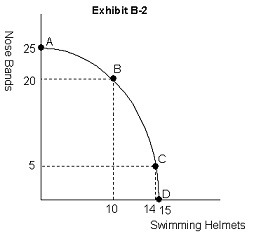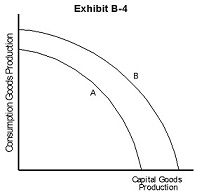What will happen in the gasoline market if oil prices rise| Microeconomics
1. The study of microeconomics and macroeconomics differ in that
a. microeconomics is concerned with the domestic economy, while macroeconomics is
concerned only with the international economy
b. microeconomics examines the individual units of the economy, while macroeconomics studies the whole economy
c. microeconomics studies the actions of households, while macroeconomics studies the actions of business firms
d. microeconomics studies the economy in terms of private individuals and firms, while macroeconomics includes the effect of government
2. Which of the following correctly matches the income payment with the resource?
a. rent-land; wages-labor; interest-capital; profits-entrepreneurship
b. profits-land; wages-labor; rent-capital; interest-entrepreneurship
c. taxes-land; interest-labor; rent-capital; profits-entrepreneurship
d. interest-land; taxes-labor; interest-capital; rent-entrepreneurship
3. A shortage of a good means
a. an excess supply of the good
b. an excess demand of the good
c. quantity demanded is less than the quantity supplied
d. the quantity supplied exceeds the quantity demanded
4. “John buys more of good X as his income increases, ceteris paribus,” means
a. there is no cause-and-effect relationship between John’s income and the quantity of good
X he purchases if ceteris paribus applies
b. John’s demand for good X depends exclusively on income
c. John’s income and purchases of this good are being held constant
d. the change in John’s income is the only factor being considered in explaining the change in his purchase of good X
5. A normal good is a good for which demand increases as the
a. income of demanders increases
b. Price of the good increases
c. Price of close substitutes decreases
d. total number of consumers decreases
6. Starting from point B in Exhibit B-2, the opportunity cost of 4 more swimming helmets is
a. 20 nose bands
b. 5 nose bands
c. 15 nose bands
d. 4 swimming helmets

7. The Secretary of Labor states that wage rates in the country have risen by 2 percent this past year. The head of a local labor union states that wage gains should have been higher. The Secretary’s statement is a(n) economic statement, and the labor head’s statement is a(n) economic statement.
a. incorrect; correct
b. normative; positive
c. positive; normative
d. correct, incorrect
Exhibit B-3
| A | B | C | D | E | |
| Capital Goods | 0 | 1 | 2 | 3 | 4 |
| Consumption Goods | 25 | 23 | 19 | 13 | 0 |
8. Exhibit B-3 shows an economy’s production possibilities table. As additional units of capital goods are produced, the opportunity cost in terms of sacrificed units of consumption goods
a. decreases because greater efficiency in production
b. increases because of decreasing opportunity cost
c. increases because of different factor productivities.
d. increases because of greater efficiency in production
9. Exhibit B-3 shows an economy’s production possibilities table. The first unit of capital goods production will cost units of consumption goods
a. 1
b. 25
c. 23
d. 2
10. Exhibit B-3 shows an economy’s production possibilities table. The second unit of capital goods production will cost units of consumption goods
a. 4
b. 25
c. 23
d. 1
11. Exhibit B-3 shows an economy’s production possibilities table. The last unit of capital goods production will cost units of consumption goods.
a. 4
b. 25
c. 13
d. 1
12. Farmers can produce wheat and/or rice. What will happen in the wheat market if there is an increase in demand for rice?
a. Wheat supply will increase.
b. Wheat supply will decrease.
c. Wheat demand will increase.
d. Wheat demand will decrease.
13. Farmers can produce wheat and/or rice. What will happen in the wheat market if there is an increase in the price of fertilizers?
a. Wheat supply will increase.
b. Wheat prices will rise.
c. Wheat demand will increase.
d. Wheat demand will decrease.
14. What will happen in the oil market if suppliers become more optimistic?
a. Oil supply will increase.
b. Oil prices will rise.
c. Oil supply will decrease.
d. Oil demand will decrease.
15. What will happen in the gasoline market if oil prices rise?
a. Gas supply will increase.
b. Gas prices will fall.
c. Gas demand will decrease.
d. Gas prices will rise.
16. What will happen in the syrup market if honey prices rise?
a. Prices will fall.
b. Demand will increase.
c. Supply will decrease.
d. Indeterminable.
17. What will happen in the tomato market if a freeze destroys a significant share of market supply?
a. Prices will fall.
b. Demand will increase.
c. Supply will decrease.
d. Indeterminable.
18. What will happen in the cell phone market as technology improvements bring costs down?
a. Prices will rise.
b. Demand will increase.
c. Supply will decrease.
d. Quantity-demanded will increase.
19. Which of the following could cause the supply of carrots to decrease?
a. Consumers’ incomes decrease.
b. There is a technological advance in carrot production.
c. Fertilizer costs increase.
d. The number of farmers growing carrots increases.
20. Which of the following could cause the demand of cds to decrease?
a. Consumers’ incomes decrease.
b. Supply of cds increases
c. Factor costs increase.
d. The number of cd suppliers decreases.
21. If supply of apples decreases and demand for apples increases, then the equilibrium
a. price will decrease and quantity will increase
b. price will increase and quantity will decrease
c. price will increase and quantity could increase, decrease, or remain the same
d. price could increase, decrease, or remain the same and quantity will increase
22. If supply of computers increases and demand for computers increases, then the equilibrium
a. price will decrease and quantity will increase
b. price will increase and quantity will decrease
c. price will increase and quantity could increase, decrease, or remain the same
d. price could increase, decrease, or remain the same and quantity will increase
23. If supply of cars decreases and demand for cars decreases, then the equilibrium
a. price will decrease and quantity will increase
b. price will increase and quantity will decrease
c. price will increase and quantity could increase, decrease, or remain the same
d. price could increase, decrease, or remain the same and quantity will decrease
24. If supply of lumber increases and demand for lumber decreases, then the equilibrium
a. price will decrease and quantity will increase
b. price will increase and quantity will decrease
c. price will decrease and quantity could increase, decrease, or remain the same
d. price could increase, decrease, or remain the same and quantity will increase
25. In Exhibit B-4, which of the following could have caused the production possibilities curve to shift from curve A to curve B?
a. A major natural disaster
b. An increase in consumption goods production this year
c. The use of newer and more productive technology
d. A decrease in unemployment

26. Two goods are considered substitutes only if a(n)
a. decrease in the demand for one leads to a decrease in the supply of the other
b. increase in the demand for one leads to a decrease in the supply of the other
c. increase in the price of one leads to an increase in the demand for the other
d. decrease in the price of one leads to an increase in the demand for the other
27. To abstract from reality in an economic model means that
a. we include only a few of the essential aspects of reality
b. the economic study surveys only a very limited period of time
c. we include only those elements that support our hypothesis
d. the model includes every aspect of the real world
28. Which of the following is NOT a central issue in economics?
a. Why are goods/services produced?
b. What is produced?
c. Who consumes what is produced?
d. How are goods/services produced?
29. The circular flow model of the economy shows
a. the flow of money, products & factors between households and firms.
b. why specific flows occur.
c. the relationship between money and goods within households.
d. the relationship between resources and the prices of resources.
30. An economic model is
a. a plastic scaled version of the economy
b. a complete depiction of reality
c. an abstraction of reality
d. applicable to consumer behavior but not to producer behavior
31. The production possibilities curve demonstrates the basic economic principle that
a. economies are always efficient
b. assuming full employment, supply will always determine demand
c. assuming full employment, an economy is efficient only when the production of capital goods in a particular year is greater than the production of consumption goods in that year
d. assuming full employment, to produce more of any one thing, the economy must produce less of at least one other good
32. When the market generates an equilibrium price, we know that
a. the quantity demanded is higher than the quantity demanded associated with a market
that is not in equilibrium
b. excess demand and excess supply are zero
c. increases in quantity demanded are matched by increases in quantity supplied
d. it is the most profitable price for suppliers
33. Which of the following activities would occur in a factor market?
a. Pam buys a ticket to the ball game.
b. General Motors hires additional workers to run a third shift at its Flint, Michigan, factory.
c. Reesa buys a new computer to help balance her personal checkbook.
d. Ian mows his grass.
34. The law of demand says that the lower the price, the
a. greater is the quantity demanded
b. greater is the demand for the good
c. smaller is the demand for the good
d. smaller is the quantity demanded
35. Which of the following is NOT a capital good?
a. Tools
b. Money
c. Lumber
d. Furniture
36. The PPF is negatively sloped because of the
a. Law of Increasing Costs
b. Principal of Substitution
c. Law of Scarcity
d. Principle of Market Efficiency
37. Which one is NOT a market failure?
a. Macroeconomic instability
b. Externalities
c. Market power
d. Price controls
Table J
|
Super computer |
Cars |
|
|
Japan |
1 |
5 |
|
US |
5 |
10 |
38. From Table J, what is the opportunity cost for Japan of 1 car?
a. 10 US cars
b. 5 US supercomputers
c. 1/5 supercomputers
d. 5 supercomputers
39. From Table J, what is the opportunity cost for the US of 1 super computer?
a. 1 Japan supercomputer
b. 5 Japan cars
c. 10 cars
d. 2 cars
40. Which country will make cars
a. Neither
b. Indeterminable
c. Japan
d. US